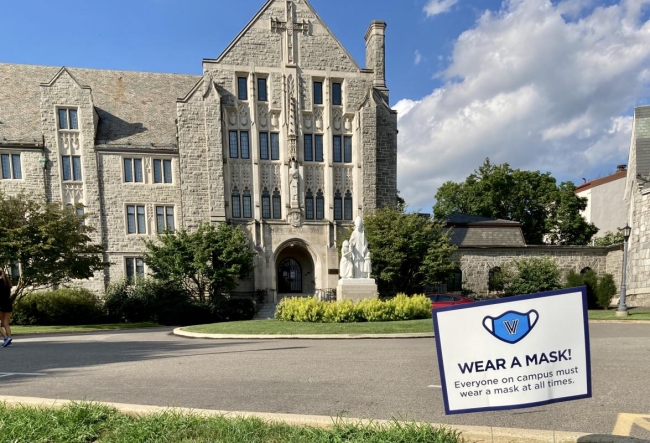You have /5 articles left.
Sign up for a free account or log in.

Villanova University
Lilah Burke
On the sidewalks of Villanova University, every student is wearing a mask. They gather in small groups to eat dinner under the sunset, lowering their face coverings to eat from takeout containers.
The dining hall is filled with long tables, cut by layers and layers of Plexiglas, encasing each diner in something of a tunnel and separating them from the people seated nearby.
In lecture halls, students sit glassy-eyed, spread strategically about the rooms. Maximum room capacity, ranging from 56 down to one, is written on the door of every room of every size.
Windows remain open. Tents have been erected outside for students to use as study spaces, to have lunch, or to otherwise use at their leisure. And of course, there are parts of the university that visitors cannot enter, such as residence halls.
Small indiscretions occur here and there. Students sit on benches labeled “Do not sit” or lower their masks for phone calls. But the campus seems otherwise orderly.
The higher education sphere has seen an undercurrent of pessimism about colleges reopening. Cases have soared at some large universities and many colleges have sent their students home. Some have said the experiment of inviting students back was doomed and dangerous from the start.
Others have taken a more positive outlook. Health officials at the University of Alabama, which has seen nearly 2,000 cumulative cases this semester, defended their strategies last weekend, saying "nothing has gone wrong" with their approach.
Of course, not everyone is dealing with such high caseloads. Villanova, which Inside Higher Ed visited in mid-August, has had only 64 published cases since the start of the semester. Though the Pennsylvania university is much smaller than Alabama’s campus (Villanova has 10,800 students, while Alabama has over 38,000), it is also dealing with a lower positivity rate.
Deciding whether colleges can or have reopened successfully depends on one's definition of success.
Gerri Taylor, co-chair of the American College Health Association’s COVID-19 task force, said she doesn’t see high case numbers as evidence of failure.
“They have been working day and night, tirelessly, to develop plans, to learn from others, to collaborate with public health,” she said. Large numbers are often from large institutions, and there isn’t currently a standard for reporting case numbers or other data, she said.
Dr. Georges Benjamin, executive director of the American Public Health Association, said some colleges are evidently struggling. But struggling, he said, has less to do with absolute cases and more to do with an administration’s ability to manage those cases.
“You could have five cases and say, ‘I can’t handle this,’ and decide to go all virtual,” he said. Even dealing with a low number of cases might be too much for an administration, since that situation still requires sanitizing, mitigating exposure and communicating with students and parents.
Benjamin said the high case numbers and difficulty some institutions are facing were to be expected.
“You take people who haven’t been around each other and you put them in a conjugate setting, you’re going to get an outbreak,” he said. “Obviously this is not a disease we want anyone to have, but no one thought we were going to stay in our houses for a year and a half or until we have a vaccine.”
“All of us in public health knew that as we reopened society, we were going to have disease outbreaks. The goal was to reduce them as much as we could and try to protect the most vulnerable in this process,” he added. “Schools are not any different from the rest of our society.”
But colleges also had a responsibility to communicate transparently with students.
“Students were functionally forced back to campus,” he said. “If anyone gave people misperceptions as to how safe they would be, I think that’s wrong.”
Craig Roberts, a former epidemiologist with the University of Wisconsin at Madison and a member of ACHA’s COVID-19 task force, said he’s generally been pleased with the reopenings he’s seen and does not feel reopening was irresponsible.
“At this point in time, COVID is essentially ubiquitous in our society, and there really isn’t any part of our culture or society that can really expect to exclude infection from happening,” he said. “At this point schools are going forward with ways to manage illness on their campus rather than exclude illness on their campus.”
Roberts said it's not always true that home is safer for students than campus. Sending students away from campus, he said, can just make their health someone else’s problem.
“There’s an assumption that people are safe at home and they’re only at risk when they come to college, and I don’t think that’s true for many young adults,” he said. “People are still going to have a risk of infection whether they are sitting in a college setting or they’re back home or working.”
Though some have said students may be more likely to gather or break rules at college, Roberts said he is not aware of any data that shows college students as a population have a higher incidence of the disease than other populations do.
Although there is no campus that can expect to exclude COVID-19, experts said colleges that test their asymptomatic students prior to arrival and often after that are likely to fare better. The Centers for Disease Control and Prevention declined to recommend those measures for higher education institutions.
Benjamin explained that entry testing can give a false sense of security. Tests can often miss some cases and don’t prevent people from getting infected immediately after they take the test. Many colleges and local public health systems may not have the supply of tests to check students every day. However, entry testing does allow the university to exclude obvious infections from campus.
“It’s a risk-reduction strategy and the question is, is it worth the money? For some schools they’ve decided that it is,” he said.
Though large colleges have captivated public attention with their caseloads, experts said they are not necessarily worse off than their smaller peer institutions.
Small colleges may be better able to stay on top of cases, but they also have smaller health operations and fewer resources, Taylor said. It’s easier for an outbreak to get out of control.
Benjamin said some of the biggest predictors of success for colleges are low prevalence of disease in the surrounding community and low prevalence in the areas students are arriving from. Large institutions, he said, may be more likely to have students arriving from many different regions.
“If they’ve done everything a reasonable person could do to try to limit that risk,” Benjamin said, “I don’t know that you can blame schools for trying.”








